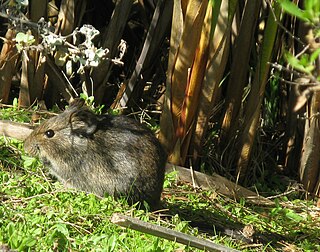
Cancer irroratus is a crab in the genus Cancer. It is found from Iceland to South Carolina at depths up to 2,600 ft (790 m), and reaches 133 mm (5.2 in) across the carapace.

African vlei rats (Otomys), also known as groove-toothed rats, live in many areas of sub-Saharan Africa. Most species live in marshlands, grasslands, and similar habitats and feed on the vegetation of such areas, occasionally supplementing it with roots and seeds. The name "vlei" refers to the South African term for intermittent, seasonal, or perennial bodies of standing water.

The Southern African vlei rat is a species of rodent in the vlei rat genus, Otomys, of the family Muridae in the order Rodentia. This is the type species of the genus. It is native to the grasslands and swamps of southern Africa where it is a common species.

The Mount Elgon vlei rat is a species of rodent in the family Muridae. It is endemic to Mount Elgon, an extinct volcano on the border between west-central Kenya and south-eastern Uganda. As of 2021, it is considered near threatened by the International Union for the Conservation of Nature and is under threat from fires and unsustainable resource extraction by humans.

Heteromys is a genus of rodents in the family Heteromyidae, commonly known as spiny pocket mice. It is the only extant genus in the subfamily Heteromyinae which also includes the extinct genera Diprionomys and Metaliomys. Heteromys was recently enlarged by inclusion of the members of formerly recognized heteromyine genus Liomys, which was found to be paraphyletic.

The Mexican spiny pocket mouse is a species of rodent in the family Heteromyidae. It is native to Mexico and Texas in the United States where it is found in dry, scrubby habitats. The IUCN has assessed it as being of "least concern". It was formerly placed in the genus Liomys, which is now recognized to be paraphyletic and has been subsumed into Heteromys.

The painted spiny pocket mouse is a species of rodent in the family Heteromyidae. It is found in Mexico and the northern tip of Guatemala. It was formerly placed in the genus Liomys, which is now recognized to be paraphyletic and has been subsumed into Heteromys.

Callimetopus, described by Émile Blanchard in 1853, is a genus of longhorn beetle belonging to the subfamily Lamiinae, tribe Pteropliini. It is widespread in South-western Asia with many species in the Philippines and the adjacent islands and includes the following species:
Orthomegas irroratus is a species of beetle in the family Cerambycidae. It is found in Colombia.

Achthophora is a genus of longhorn beetles of the subfamily Lamiinae, containing the following species:

Myagrus is a genus of longhorn beetles of the subfamily Lamiinae, containing the following species:
Paradiallus is a genus of longhorned beetles in the family Cerambycidae. There are about seven described species in Paradiallus, found in Southeast Asia.

Cacia is a genus of longhorn beetles of the subfamily Lamiinae.

Pterochaos irroratus is a species of beetle in the family Cerambycidae, and the only species in the genus Pterochaos.
Myagrus vinosus is a species of beetle in the family Cerambycidae. It was described by Francis Polkinghorne Pascoe in 1866, originally under the genus Pharsalia. It is known from Borneo, the Philippines, Malaysia and Sumatra. It feeds on Ficus elastica.
Paradiallus irroratus is a species of beetle in the family Cerambycidae, and the type species of its genus. It was described by Heller in 1924, originally under the genus Xoes. It is known from the Philippines.

Callimetopus irroratus is a species of beetle in the family Cerambycidae. It was described by Newman in 1842, originally under the genus Euclea. It is known from the Philippines.

Paraphlepsius irroratus, known generally as bespeckled leafhopper, is a species of leafhopper in the family Cicadellidae. Other common names include the irrorate leafhopper and brown-speckled leafhopper.
Cryptocephalus irroratus is a species of case-bearing leaf beetle in the family Chrysomelidae. It is found in Central America and North America.
Tetracoscinodon is a genus of mosses belonging to the family Pottiaceae.













